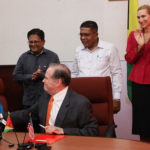Questions Posed by the Natural Resources Parliamentary Sectoral Committee, July 21, 2014
1. Are there any plans to decentralize GSA in Regions 9 & 10 where agriculture is further increasing? – Mr. Trevor Williams.
Yes, there are plans to decentralize the GSA in other regions to support agriculture development in the medium to long term. In addition to decentralization there are plans to offer specific demand driven courses via distance learning. With distance learning, it is envisaged that practical exposure would be gained from attachment at farms operated by agencies within the Ministry of Agriculture – GLDA Livestock Farm at St. Ignatius and Ebini and NAREI’s Farms at St. Ignatius and Ebini. An online course on crop production is currently being prepared.
2. Majority of the Secondary Schools are doing Agriculture Science at the CXC level. Does the Ministry of Agriculture collaborate with the Ministry of Education on agriculture at the school level?
Yes. In each region, the Ministry of Agriculture Extension Coordinators serves as liaison officers between the Ministry of Agriculture and the Regional Democratic Council on which the Ministry of Education and other Ministries are represented. At these meetings of the RDC, agricultural programmes for the regions are discussed and areas for collaboration are worked out.
Collaborative efforts with the Ministry of Education at the School level include the supply of seeds and other inputs for school farms, provision of technical expertise in protected agriculture, promotion of hydroponics in Schools with the Inter-American Institute for Cooperation on Agriculture, participation in the career fairs sponsored by the Ministry of Education via the Guyana School of Agriculture and the use of the facilities of the Ministry of Agriculture for practical experience and completion of School Based Assessment for CXC Agriculture Science.
Facilities utilized include NAREI’s demonstration farms and nurseries, GLDA’s farms, the aquaculture station and the GSA’s farms. The Guyana School of Agriculture also conducts outreach to schools to promote its programmes and to increase students awareness of the fields and areas that exist in agriculture. CARDI’s work to develop a curriculum for CXC for the Introduction of Agriculture at the CAPE level involved collaborative work among the Ministries of Agriculture and Education in each Caribbean Country.
Guyana is one of the countries in which Agriculture would be offered for the first time and the Ministries of Agriculture and Education, would have collaborated with CARDI in the development of the curriculum for this subject. At the CAPE Agriculture Science Launch in Guyana, the feature address was delivered by the Minister of Agriculture.
GSA Summer Programme Concept
The GSA’s Summer Programme Concept is designed to satisfy training needs for farmers, women, youths, technicians, teachers and Extension Officer’s in specific areas during the period that School is closed. These are short duration courses, two to three days, which would not take the persons involved, especially farmers away from their work for very long.
During the summer vacation the following training programmes are conducted:
1. Product Development Training for Small Agro-Processors. This training is done with funding from the READ Project of the Ministry of Agriculture and benefits the small agro-processors which fall under the regions covered by this project – Regions 2, 3, 4, 5, 6, and 10. These training programmes are of a two day duration and are mostly conducted in the farming communities. Participants are exposes to both the theoretical and practical aspects of products the Product Development Training is aimed at helping producers to improve the quality of their products so that they can be more easily marketed and for them to better utilize produce from their farms. Products developed include pepper sauce, ketchup, green seasonings, jams and jellies, preserved fruits, pickled vegetables, preservation of meats, fish and milk. This training commenced in 2011. By August 2014 members of 52 Community Based Organisations would have benefitted.
Skill training courses.
Two short skill training courses were introduced in the summer of 2013. These include:
(a) Operation, Repairs and Maintenance of Small Equipment.
Target Audience: Field Workers, Technicians and Farmers.
Terminal Competencies:1. Observing safety precautions during operation of equipment.
2. Disassembling and reassembling equipment.
3. Maintenance and troubleshooting techniques.
4. General maintenance procedures and tests that should be conducted on the main parts.
5. Determining the specific parts to check when equipment fails to start.
(b) Urban Agriculture Techniques – Grow Box/Hydroponics
Target Audience: Urban Farming, Field Technician and Teachers.
Terminal Competencies: 1. Basic concepts of Urban Agriculture and Climate Change.
2. Plant nutrition and Soil mixtures.
3. Construction and maintenance of Grow Box.
4. Hydroponics – The basics
5. Shade house: consideration and construction.
6. Planting and maintenance.
7. Post harvest and marketing.
These two programmes are conducted at the School and each runs for a period of three days.
Questions Posed by the Natural Resources Parliamentary Sectoral Committee, July 21, 2014
1. How long will it take for GLDA to have the White Paper completed on Land matters in relation to livestock?
A draft document has been completed and submitted to central Ministry for consideration.
2. Give a Status Report on GLDA’s Embryo Transfer Programme?
Semen has been used very successfully in extending genetically superior characteristics of the bovine male. This technique is now quite well used in Guyana, particularly for dairy animals. For superior females, their genes can be extended by embryos which are implanted in surrogate mothers. Embryos are very small, about the size of a speck of sand and are stored in liquid nitrogen prior to use. Guyana has begun to use this technique of improving our genetic base for beef animals in 2012 as part of the Agriculture Diversification Project of the Ministry of Agriculture.
The first training programme took place in 2012 in which an overseas consultant veterinarian, Claudio Quiros trained a number of our staff, including the head of the Genetics Department of GLDA. Some 31 embryos were implanted in 2012. In 2013, 61 embryos were implanted; the corresponding figure for 2014 up to May 2014 is 49.
As a result of the embryos implanted, 24 calves were born in 2013 and 6 calves as at June 2014.
3. It has been reported that staffers of GLDA do not follow up on calves emanating out of the AI Programme?
We do follow up on calves born under the genetic improvement programme. This includes gathering data that is compiled into a calf birth certificate. During our thousands of farm visits per year, calves from part of routine advisory or extension activities.
Over 700 calves from AI are born in an average year. Some of these calves are found in remote areas- on the banks of the upper reaches of rivers and savannahs. Questions of efficient use of human and material resources always remain foremost in our minds and often dictate farm visits by our staff.
It is recognized that an AI calf is a high quality animal which owes its existence to a special highly subsidized programme for farmers. The recipients as well as GLDA have a joint responsibility to take the best care of these calves. GLDA remains committed to providing quality service to such farmers.
4. Mr. Neil Kumar requested additional information on cattle rearing in Guyana?
Cattle rearing has been done in Guyana since European Colonisers came to the part of the world. Several decades ago, Guyana was an exporter of beef with animals being grass fed in the Rupununi and then transferred to Ebini for fattening and slaughter. With the advent of Foot- Mouth Disease in the 1970’s, as well as combination of factors, cattle production declined in Region 9 and begun to shift to the coastal regions.
As these locations, many farmers keep their animals close to their homes for security reasons. Bigger farmers established ranches more in land in Regions 2, 3, 4, 5, 6 and 10. However such lands almost always, do not have drainage and irrigation, lack farm to market roads/ dams and are generally marginal lands in terms of productivity.
Government has been targeting the sector with a view to developing a commodity value chain. Under this programme, the following have been initiated completed:
-rebuilding of infrastructure- roads, buildings, laboratories
-purchase of farm equipment and machines
-setting of a semi-autonomous body (GLDA) to deal with all aspects of livestock matters.
-training of livestock staff in specialised areas
-rehabilitation of pastures
-rehabilitation of drainage and irrigation facilities
A strategic Plan for the Agriculture Sector 2013- 2020 has been developed and livestock, including cattle plays an important role as a contributor to food security and contribution to GDP. As Guyana eyes the export market, a lot has to be done to gear up our cattle production to meet the standards of increasingly discerning markets.
5. . Mr. Harmon- Have the MOA implemented any mechanism to address overfishing in the offshore?
- Based on scientific research, there has been a reduction of the seabob trawler fleet from 104 vessels to 87 vessels and there is an annual closed season of 4-6 weeks for this fleet. A Harvest Control Rule is also being implemented for this fleet. Bycatch reduction devices have also been installed to reduce the capture of non target species. Vessel Monitoring Systems devices are being installed on all trawlers (seabob and prawns) to monitor their activities and enforce designated no trawl zones.
- Annual stock assessments will be conducted from which composition of biomass and species will be determined. This information will be used determine the composition of the various fleets and limited use of gears per vessel. The department is represented at the CRFM Annual Scientific meetings at which the data collected is analysed and the results verified and published.
- Increased monitoring and enforcement through collaboration with agencies such as the Guyana Defence Force Coast Guard, the Marine Police and Maritime Administration
- The department and the WWF have started a pilot project to collect bycatch data from the artisanal fleet.
6. Does the MOA have the issue of foreign vessels invading Guyana to steal fishing and how are we handling this?
Yes, the MOA has received reports of foreign vessels entering Guyana’s EEZ and conducting illegal fishing activities. This issue is being handled by the Guyana Defence Force Coast Guard which has the responsibility for protecting the sovereignty of the EEZ. The GDF CG would usually conduct patrols and aerial reconnaissance which have resulted in the apprehension / detention of illegal vessels. Captains of illegal vessels have been placed before the courts and have been fined and their catch confiscated.





